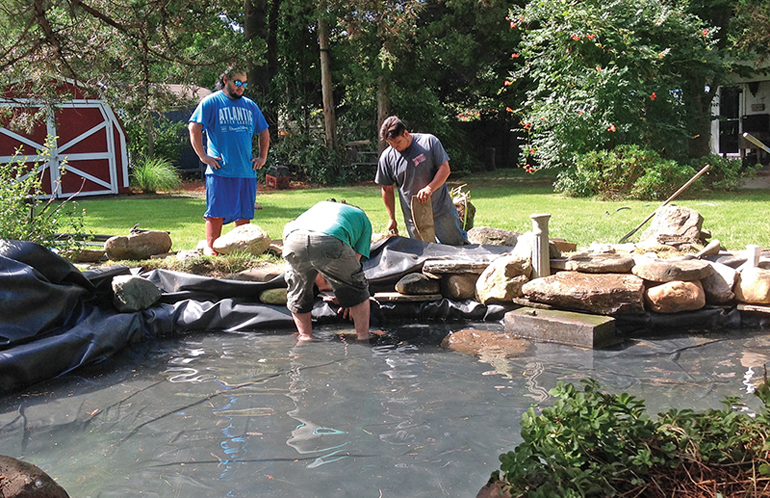
My dentist told me about Lily. She had a great relationship with Dr. K — we all do — and had been chatting during a checkup about a problem with her pond. A widow, she was at an impasse over what to do about her backyard koi pond, which was leaking badly. For many years since she was widowed, she had kept up the pond herself. It was her husband’s pride and joy. He had built it himself some 40 years earlier, and they had tended it lovingly together until he passed away. She was still tending the pond every week, just the way they used to together, but now she was alone — and pushing 80. It was no easy task.
Lily’s Pond: Before
The pond measured 20 feet across and nearly 40 feet long with a dozen waterlilies and tons of floating plants. There a was a tiny waterfall at one end and three frog spitters at the other, each powered by its own little magdrive pump, which clogged up like clockwork. Every Saturday she would sit down at the edge of the pond, slide in ever so carefully and make her way across the sloped, slippery bottom to clean each of the pumps, Then, she pruned and deadheaded every waterlily. The task got harder for Lily every year, and not just because of her age. Stones along the edge had loosened; some had fallen in. The bare liner was slicker than a New York City con man. The pond bottom had settled over the years. Living roots had pushed up ridges across the bottom of the pond, which was almost 3 feet deep in the middle. Dead roots had rotted away and left deep pockets. Through it all, the pond endured — a tribute to her beloved.
Now, she faced a terrible choice. At 80 years young, she was still willing and able to continue to maintain the pond, dismissing the risk of injury with a chuckle, but time had caught up to the pond itself. After 40 years in the ground — an amazing testament to the quality of both the installation and the material — the pond had started to leak, basically everywhere. The dilemma she shared with her dentist was simple, but it was more painful to her than pulling teeth. She could fill in the pond and be left with only the memory of it intact, or she could renovate it, knowing that it would require the removal of every stone her husband had so carefully laid.
Dr. K asked me to call her, and we arranged to meet. My son Edwin found the problem almost instantly. “Dad, there are so many tiny holes that I can see through this liner.”
After four decades in the ground, the liner was finally and literally falling apart. I gave her a price to fill it in, which was no bargain, because there was no way to get a machine into the area. However, I asked her to trust me to rebuild the pond instead, even though it was more expensive of a proposition. I had taken to her instantly and wanted the chance to make her pond into something she could continue to love — safely.

Lily is not alone. The baby boomers who built so many of their own water features are aging, and the maintenance that they willingly accepted, and even enjoyed, is becoming more difficult. As features age, they eventually require renovating to deal with erosion and settling, to replace liner and failing equipment and even to modernize outdated styling. The trend that we see is that renovations now make up almost as much of our work as new installations, and as the market becomes more saturated, that trend will continue. It’s becoming clear that we should be addressing the need to make access and maintenance easier on every install, for every customer.
Edge Profile
The most critical area for easy accessibility is, of course, the edge of the pond. Getting in and out is when most accidents happen. Although it might seem a little counterintuitive, a sloped beach or ramp is not safe. Whether the bottom is graveled or bare, the biofilm that will grow on every surface will make any slope extremely hazardous. For safest access, the side wall of the pond should have a vertical drop from the rocks that make up the coping straight down about 18 inches to a flat, level shelf all the way around. This allows for entering the pond with a single step onto a flat surface, while sitting on or holding onto the rocks along the edge. While creating simple steps down into the pond is common practice, having a first step that’s around knee-deep offers other benefits, also.

It’s a good depth for waterlilies, adds additional volume and keeps out wading predators like raccoons and herons. Unlike this deeper plant shelf, shallows around the perimeter allow predators in and provide areas where algae and mosquitoes can thrive.
Easy Access to Filtration
Having the pump or, in Lily’s case, pumps in the bottom of the pond certainly works but makes servicing more complicated and sometimes even dangerous. The first innovation we recommended was a skimmer with a single, larger high-efficiency pump plumbed to the waterfall and the spitters. This put all the pump maintenance outside the pond, and it provided a net and mat to trap floating debris before it could sink to the bottom.
In another case, where the client already had a skimmer, it had been set so low that the customer literally risked falling into the pond headfirst every time the net needed cleaning. The solution there was to raise the water level when we renovated the pond. Then, we created a subtle berm around the pond that kept rain from washing dirt and mulch in. Once we had set the levels, we pulled the skimmer way back from the edge, lowered the soil around the back of the skimmer and set a flagstone there for secure footing. When we were done, the top of the skimmer net was easily accessible well above soil level instead of a foot below the surrounding grade, and our customer could then maintain the pond safely.

Low-Maintenance Design
Renovation offers the ideal opportunity to reduce both maintenance and operating costs, benefiting every client. The less effort it takes, the better a pond or water feature is maintained, and the happier your customer is — and that leads to referral business. Better equipment these days is easier to keep clean while at the same time keeping the pond cleaner. Use an edge and bottom profile designed to be safer. We like to make pockets with bottom drains that collect and filter wastes automatically, delivering them to biological filters that need to be cleaned only twice a season, or to active bogs that can go for years without cleaning. Use high-efficiency, asynchronous pumps in skimmers to cut both maintenance time and operating costs.
Lily’s Pond: After
What we did for Lily is a good example. She still wants to get into her pond to maintain her waterlilies, so we carefully took pictures of where all the rocks were, pulled the old liner out and graded out the bottom perfectly flat. We reset the stones at the edge of the pond on a solid rock shelf and then created a vertical drop down to a plant shelf. This RSVP profile keeps algae, mosquitoes and predators at bay, but most importantly for Lily, it makes it easy to get in and out of her pond. We installed the columnar base of a bird bath as a newel post for her to hold onto as she steps down into the pond, and the waterlilies are all set just one step apart, so she can hold onto them as she walks across the smooth, level bottom. She no longer needs to clean multiple clogged pumps in the ponds — only the net in the skimmer once a week, and occasionally the mat. The pump technology has progressed to the point that the single larger pump actually costs less to run now, too — a prime consideration for those on a fixed income. Best of all, she tells me that we recreated the pond the way her husband had envisioned it, using the same stones in the same places.
Now she feels safe again, doing what she loves. For us, that’s what it’s all about.



I hang out with fish I play in the water play in the dirt and I’ll play with rocks it’s every 10 year old fantasy I’m a pond Builder I love my job